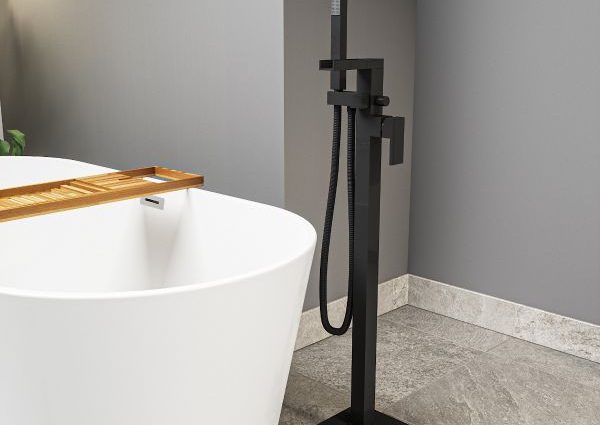PHOTO: www.radiatoroutlet.co.uk
Choosing the right taps for your home involves considering various factors such as functionality, style, budget, and compatibility with your existing plumbing system. Here are some key points to consider when selecting taps:
Functionality
Determine the primary use of the taps. Are they for a bathroom sink, kitchen sink, bathtub, or shower? Each type of tap serves a different purpose and has specific features tailored to its function.
Material
Taps are commonly made from materials like brass, stainless steel, chrome, nickel, and bronze. Each material offers different aesthetic appeal, durability, and maintenance requirements. Choose a material that complements your overall decor and withstands the conditions of its environment.
Style
Consider the design style of your home and choose taps that align with it. Whether you prefer modern, traditional, vintage, or industrial aesthetics, there are taps available to suit every taste. Look for cohesive designs that enhance the overall look of your space.
Finish
Taps come in a variety of finishes, including polished chrome, brushed nickel, matte black, oil-rubbed bronze, and more. Select a finish that coordinates with other fixtures in the room for a cohesive look.
Water Efficiency
Opt for taps that are water-efficient to help conserve water and reduce your utility bills. Look for products labeled with WaterSense certification, indicating they meet water efficiency and performance criteria set by the Environmental Protection Agency (EPA).
Handle Type
Taps can have different types of handles, such as single-handle, double-handle, or touchless (sensor-operated). Consider which type of handle is most convenient and ergonomic for your needs.
Installation Requirements
Ensure that the taps you choose are compatible with your existing plumbing setup. Check the dimensions, mounting options, and installation requirements to avoid any compatibility issues.
Brand Reputation and Quality
Invest in taps from reputable brands known for their quality craftsmanship and reliability. While these products may come at a higher initial cost, they often offer better performance and durability in the long run.
Budget
Set a budget for your tap purchase and explore options within that range. Consider the overall value, including factors like durability, warranty, and long-term maintenance costs, rather than just the upfront price.
Reviews and Recommendations
Research tap options online, read reviews from other homeowners, and seek recommendations from friends, family, or professionals in the industry. Their experiences can provide valuable insights to help you make an informed decision.
Picking The Right Tap Design
Taps come in various types, each tailored to specific functions and design preferences. Here’s an overview of different types of taps commonly used in both kitchens and bathrooms:
Types of Taps for Kitchens:
Kitchen Sink Mixer Taps: These taps combine hot and cold water streams into a single spout, controlled by a single lever or handle. Kitchen sink mixer taps are versatile and practical, allowing users to adjust the water temperature and flow with ease. They are available in various designs to complement different kitchen styles.
Pull-Out or Pull-Down Taps: These taps feature a spray head that can be pulled out or down from the main body of the tap. Pull-out or pull-down taps are convenient for tasks like washing dishes and filling pots that require flexibility and reach. They often come with different spray settings for enhanced functionality.
Bridge Taps: Bridge taps have a traditional design with separate hot and cold water handles mounted on a bridge-like structure above the sink. They add a classic touch to the kitchen decor and are available in a range of finishes to match different aesthetic preferences.
Filtered Water Taps: These taps are equipped with built-in water filtration systems, providing access to filtered drinking water directly from the tap. They eliminate the need for separate filtration devices and are ideal for households that prioritize water quality and convenience.
Touchless or Sensor Taps: Touchless taps use motion sensors to detect the presence of hands and automatically activate the flow of water. They offer a hygienic and convenient solution, reducing the spread of germs and minimizing water wastage by shutting off automatically when not in use.
Types of Taps for Bathrooms:
Waterfall Taps: Waterfall taps are a popular choice for both kitchen and bathroom applications, known for their unique and stylish design that mimics the natural flow of water cascading down a waterfall. These taps feature a wide, flat spout that allows water to flow out in a gentle, sheet-like manner, creating a visually striking effect.
Basin Mixer Taps: Similar to kitchen sink mixer taps, basin mixer taps combine hot and cold water streams into a single spout, controlled by a single lever or handle. They are commonly used for bathroom sinks and vanities, providing easy temperature and flow adjustment.
Center-Set Taps: Center-set taps feature a single unit with both hot and cold water handles integrated into a single base. They are typically used for bathroom sinks with three holes, where the handles and spout are installed close together on a center-mounted base.
Wall-Mounted Taps: These taps are installed directly on the wall above the basin or bathtub, rather than on the sink or countertop. Wall-mounted taps create a sleek and minimalist look, freeing up space on the basin for other bathroom essentials.
Freestanding Taps: Freestanding taps are tall, standalone fixtures that are mounted directly on the floor next to the bathtub or basin. They add a touch of luxury and elegance to the bathroom and are often used in contemporary or spa-inspired designs.
Deck-Mounted Taps: Deck-mounted taps are installed directly on the rim or deck of the bathtub, rather than on the wall or floor. They come in various styles, including traditional, modern, and waterfall designs, to complement different bathtub configurations and aesthetic preferences.
When choosing taps for your kitchen or bathroom, consider factors such as functionality, style, material, and installation requirements to ensure they meet your specific needs and enhance the overall design of the space.













